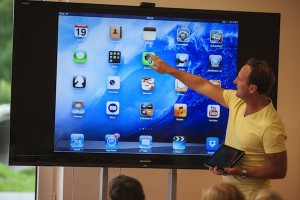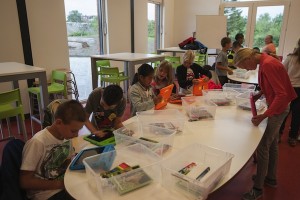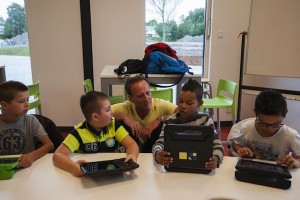Steve JobsSchools Open in Netherlands: A New Case Study in the Role of Tech in Education
 There is no doubt that technology will play an increasingly significant role in education. But there are still many important open questions about what roles hi tech should play in helping students learn and engage, what kinds of technology are best suited for the tasks, how effective technological tools can be in the learning process, and what the impacts might be on social interaction and social skill development. This is fertile territory with great promise and potential pitfalls, so it is an area deserving of careful experimentation and critical review.
There is no doubt that technology will play an increasingly significant role in education. But there are still many important open questions about what roles hi tech should play in helping students learn and engage, what kinds of technology are best suited for the tasks, how effective technological tools can be in the learning process, and what the impacts might be on social interaction and social skill development. This is fertile territory with great promise and potential pitfalls, so it is an area deserving of careful experimentation and critical review.
Today, seven trailblazing schools opened in the Netherlands, which offer one possible vision for schools that embrace technology at their core. Called the “Steve JobsSchools,” they operate according to the principles of the O4NT foundation (Education for a New Era). The role of the Apple iPad is central to the schools’ approach to learning: Every child has access to a “virtual school” through her/his iPad.
What Good Is an iPad for Student Learning?
 According to O4NT, the 58 core objectives set by the Dutch Ministry of Education can be met more effectively when every student has an iPad. The reasoning is this: If they can achieve the standard educational objectives more efficiently, then they have more time to pursue the additional goals of O4NT: promoting the child’s individual talents and developing 21st-century skills. These skills include information and communications technologies (ICT), information processing, collaboration, and developing a creative mind trained in critical thinking and problem-solving.
According to O4NT, the 58 core objectives set by the Dutch Ministry of Education can be met more effectively when every student has an iPad. The reasoning is this: If they can achieve the standard educational objectives more efficiently, then they have more time to pursue the additional goals of O4NT: promoting the child’s individual talents and developing 21st-century skills. These skills include information and communications technologies (ICT), information processing, collaboration, and developing a creative mind trained in critical thinking and problem-solving.
Clearly, this tech-based approach will have an impact on pedagogy and the role of the teacher. O4NT says that, in its approach, teachers will not merely convey knowledge to a group of children; they will serve as coaches that support children with their individual and group projects. At the Steve JobsSchools, educational apps are used for basic skills, enabling the learning process to be adapted to each individual child’s learning speed and style.
 When they are in the physical school building, students will move around the various “subject rooms” (e.g. the language room, math room, creative lab, gym, or technology lab), and other elective activities, according to their individual schedules. A special app facilitates parental engagement by allowing parents to follow their children’s activities throughout the day and monitor their portfolio, documenting their progress and achievements.
When they are in the physical school building, students will move around the various “subject rooms” (e.g. the language room, math room, creative lab, gym, or technology lab), and other elective activities, according to their individual schedules. A special app facilitates parental engagement by allowing parents to follow their children’s activities throughout the day and monitor their portfolio, documenting their progress and achievements.
Another potential benefit is that school hours and vacation periods will become more flexible. Because the “virtual school” is always available on the iPad, parents will be free to choose their children’s school hours and book family vacations at convenient times. O4NT says it is working with the Dutch Ministry of Education to overcome legislative obstacles to achieve greater flexibility in scheduling, with the objective of seamlessly integrating on-campus and off-campus learning.
Developing New Tools for Student Learning & Engagement
In developing the technology that powers the Steve JobsSchools, O4NT and its partner developers have introduced several new tools:
- The “sCoolSpace” app is a virtual schoolyard where students can meet safely in an augmented-reality environment.
- The “Tiktik sCoolTool” system manages schedules, attendance, parent contact and portfolios, all at the same time.
- Students use “sCoolProjects” to work on research projects and other assignments in small groups, supported by a coach.
- Through “iDesk Learning Tracker”, teachers and parents (and publishers) can follow the results their children achieved using educational apps.
- “DigiTalenten” will report annually on what the students’ digital life looks like and what ICT skills children have mastered.
- “Symbaloo” is used for sharing and distributing knowledge, within the school as well as between schools and O4NT.
 Distance-learning applications are also on the menu. Beginning in 2014, Dutch-speaking children around the world will be able to attend a full-time Dutch-medium education via the iPad or start a program that complements their education abroad.
Distance-learning applications are also on the menu. Beginning in 2014, Dutch-speaking children around the world will be able to attend a full-time Dutch-medium education via the iPad or start a program that complements their education abroad.
O4NT projects that, by the end of the current school year, at least twelve schools will be providing education based on the Steve JobsSchool model. The O4NT foundation is reviewing the method with school boards across the Netherlands, and they expect many more schools to adopt the O4NT principles next year.
More information about the Steve JobsSchools and O4NT, including videos and tools, can be found at www.educationforanewera.com.
US Schools Using iPads
As educators wade into the digital waters, Apple’s iPad has emerged as the tablet of choice. Just last month, Apple inked a $30 million contract with the second-largest school district in the U.S.A., Los Angeles Unified School District in California, to provide iPads for every student in the district, all preloaded with a set of educational apps. In Idaho, the “iSchool” initiative has increased student engagement and creativity while reducing costs and saving tens of thousands of sheets of paper every month. Other schools and districts across the country are following suit, and the momentum is building, so watch this space.
What do you think?
As a student, would you want your school to use technology like this? As a parent, would you want your child to attend a school like this? Let us know in the comments below.

As the article suggests, one of the important questions is how to preserve social interaction when using these potentially helpful but potentially isolating gadgets. Obviously, nobody wants kids to spend even more time gazing at a screen, disconnecting from the rest of the world. What’s interesting to me is that these educators are using the iPad as a tool to increase engagement and interaction, and if they are successful in that, then this is indeed something we need to look at seriously.